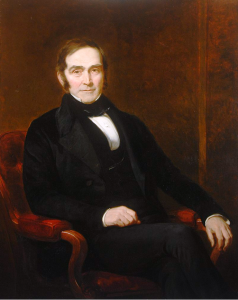
Born in 1785 to Mary and George Grey of Milfield Hill near Wooler in north Northumberland, John Grey was descended from a long line of Governors of the East Marches during the county’s Border Reiver years. He was educated at Richmond Grammar School and by the age of 18 he was already managing a large agricultural concern at home where he gained a respected and fine reputation, his father having died when John was young. In 1814 he met his beloved wife, Hannah Annett from Alnwick. She was immediately attracted to his ‘handsome appearance and high qualities of mind and heart’ and he knew that ‘his heart was no longer his own.’ They married in the winter of 1815 settling in his family home at Milfield Hill.
A strong Whig he was involved in the anti-slavery and free trade movements from the 1820s, and assisted his cousin the Earl Grey with the Reform Act of 1832. Through Earl Grey’s good offices, in 1833 Sir James Graham, First Lord of the Admiralty, offered John Grey the post of Receiver for the Greenwich Hospital’s extensive Northern Estates, a position of huge importance and influence encompassing the management of all their tenanted farms, lead mines, woodlands, mills, collieries and quarries. The salary of £1000 p.a. came with the provisos that Grey should give up all outside business interests, submit daily detailed records of his work to the Hospital’s commissioners and live near Hexham. Dilston Hall near Corbridge was duly built for the incumbent receiver, and Grey made it home for his large family. Working 16 hours a day 6 days a week John Grey increased the monetary value of the Hospital’s northern Estate by £10,000 p.a., an increase of a third. He arguably had a greater impact on local farming than any other individual during the Victorian period. He was a respected member of the Royal Agricultural Society, had papers published in its annual journal, and saw field drainage as the main source of a rental improvement of 25% during the 1850s, justifying the initial capital cost.
Grey retired in 1863 at the age of 77, three years after the death of his beloved wife Hannah, to be replaced by his son Charles. A man of integrity, substance, intelligence and a fine reputation, John Grey died in 1868 at Lipwood near Haydon Bridge after a short illness aged 82. He had still been riding to hounds only two years earlier. He was laid to rest beside Hannah and one of their children, Emily, in Corbridge churchyard. Another daughter, Josephine Butler, was the renowned social reformer.
Jennifer Norderhaugh
See also
Josephine E. Butler, Memoir of John Grey of Dilston, (revised edition, 1874)
Thompson, F. M. L. ‘Grey, John’. Oxford Dictionary of National Biography (2004)

